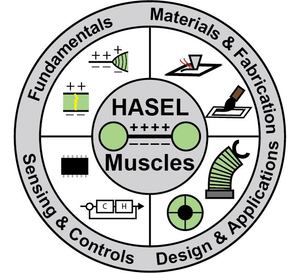HASEL Artificial Muscles for a New Generation of Lifelike Robots—Recent Progress and Future Opportunities
2021
Article
rm
Future robots and intelligent systems will autonomously navigate in unstructured environments and closely collaborate with humans; integrated with our bodies and minds, they will allow us to surpass our physical limitations. Traditional robots are mostly built from rigid, metallic components and electromagnetic motors, which make them heavy, expensive, unsafe near people, and ill-suited for unpredictable environments. By contrast, biological organisms make extensive use of soft materials and radically outperform robots in terms of dexterity, agility, and adaptability. Particularly, natural muscle—a masterpiece of evolution—has long inspired researchers to create “artificial muscles” in an attempt to replicate its versatility, seamless integration with sensing, and ability to self-heal. To date, natural muscle remains unmatched in all-round performance, but rapid advancements in soft robotics have brought viable alternatives closer than ever. Herein, the recent development of hydraulically amplified self-healing electrostatic (HASEL) actuators, a new class of high-performance, self-sensing artificial muscles that couple electrostatic and hydraulic forces to achieve diverse modes of actuation, is discussed; current designs match or exceed natural muscle in many metrics. Research on materials, designs, fabrication, modeling, and control systems for HASEL actuators is detailed. In each area, research opportunities are identified, which together lays out a roadmap for actuators with drastically improved performance. With their unique versatility and wide potential for further improvement, HASEL actuators are poised to play an important role in a paradigm shift that fundamentally challenges the current limitations of robotic hardware toward future intelligent systems that replicate the vast capabilities of biological organisms.
| Author(s): | Philipp Rothemund and Nicholas Kellaris and Shane K. Mitchell and Eric Acome and Christoph Keplinger |
| Journal: | Advanced Materials |
| Volume: | 33 |
| Number (issue): | 19 |
| Pages: | 2003375 |
| Year: | 2021 |
| Department(s): | Robotic Materials |
| Bibtex Type: | Article (article) |
| Paper Type: | Journal |
| DOI: | 10.1002/adma.202003375 |
| Note: | Nicholas Kellaris, Shane K. Mitchell, and Eric Acome contributed equally to this publication. |
|
BibTex @article{Rothemund21-AM-Progress,
title = {HASEL Artificial Muscles for a New Generation of Lifelike Robots—Recent Progress and Future Opportunities},
author = {Rothemund, Philipp and Kellaris, Nicholas and Mitchell, Shane K. and Acome, Eric and Keplinger, Christoph},
journal = {Advanced Materials},
volume = {33},
number = {19},
pages = {2003375},
year = {2021},
note = {Nicholas Kellaris, Shane K. Mitchell, and Eric Acome contributed equally to this publication.},
doi = {10.1002/adma.202003375}
}
|
|



